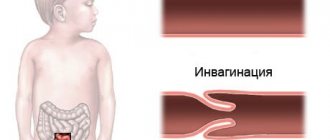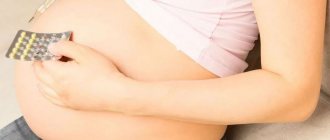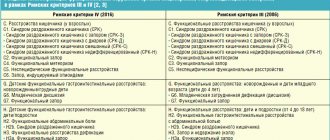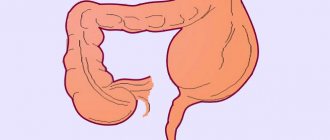Dolichosigma is an elongation of the sigmoid colon, which is part of the large intestine. Normally, its length can vary from 24 to 46 cm. With this disease, the length increases, changes occur in the tissues, which often causes stool retention.
In some people, the elongation of the sigmoid colon does not manifest itself, while others experience constipation with dolichosigma. Therefore, treatment is carried out only in the presence of intestinal dysfunction and disturbing symptoms.
In most cases, lifestyle changes and medications help cope with the consequences of the disease. But if conservative methods do not help, a complication has occurred or the risk of its development is high, the doctor may suggest surgical treatment.
Symptoms of dolichosigma
Manifestations of dolichosigma depend on the degree of elongation of the intestine, as well as changes in tone, motility, compensatory capabilities of the body and other conditions. Almost always, the disease manifests itself as constant constipation. Other associated symptoms include:
- impurities of blood in the stool - this may be due to injury to the mucous membranes of the intestine by dense feces;
- flatulence;
- pain in the left iliac region or near the navel, especially intensifying after exercise or a heavy meal, disappearing after bowel movement.
Many people with dolichosigma and its consequences may develop problems with other parts of the gastrointestinal tract. For example, Doctor of Medical Sciences Samsonov A. A. mentions in his work that with dolichosigma “the rectoanal reflex <…> is often <…> reduced” (Samsonov A. A., 2009, p. 233). Many children with this diagnosis develop pancreatitis, colitis, gastroduodenitis, etc.
Other authors also talk about complications. For example, Doctor of Medical Sciences, Professor A. E. Mashkov and a number of co-authors focus on the fact that “long-term congestion in the colon with chronic constipation in children with dolichosigma is characterized by a persistent imbalance of the intestinal microflora, secondary inflammatory and degenerative changes in the wall of the sigmoid colon "(Mashkov A. E., Rogatkin D. A., Rusanova E. V., Filyushkin Yu. N., Kulikov D. A., Sigachev A. V., 2015, p. 103).
In adults, dolichosigma and associated constipation can cause hemorrhoids, thrombosis of hemorrhoids, anal fissures, etc. Therefore, the symptoms of the underlying disease can be combined with manifestations of its complications.
Chronic constipation with dolichosigma can lead to the formation of fecal blockages, severe intoxication, anemia, and irritable bowel syndrome. The most serious complications include intestinal obstruction, which requires urgent surgical intervention.
When visiting a gastroenterologist, patients often complain about such a delicate problem that significantly affects the quality of life as constipation. According to the latest population-based study MUSA, conducted in 2011 in Moscow, the prevalence of constipation classified according to Rome III criteria is 16.5% among the adult population. The incidence of constipation consistently increases with age and among 18-24 year olds is 3.6%, 45-54 year olds - 17.8%, and in patients over 65 years old it increases to 32.8%. Gender differences (women/men) in the incidence of constipation are generally 2.1 (in the group of people 18-24 years old - 1.2, 25-34 years old - 2.4, 35-44 years old - 2.1, 45-54 years old - 3.2, 55-64 - 1.9, from 65 years and older - 2.7) [1]. A difficult problem remains the choice of effective therapy, taking into account the patient’s age, concomitant diseases, the mechanism of development of constipation, and based on European standards of approaches to the treatment of this disease. To resolve the issue of treating constipation and choosing a laxative drug, it is necessary to understand the violation of the physiological mechanisms of intestinal motor activity.
Constipation (constipation) is a pathological condition of the intestine, reflecting a violation of its motor-evacuation function, developing both primarily against the background of functional disorders or idiopathically, and secondarily due to damage to the anatomical and functional structures of the colon, with pathology of the digestive organs, neurological, endocrine and metabolic diseases . Regulation of intestinal peristaltic activity is ensured by myogenic, enteral mechanisms, the central and autonomic nervous systems, humoral mechanisms are realized through hormones of enteral and non-enteric origin, motor activity also depends on the influence of bile acids, digestive secretions, composition and metabolites of intestinal microflora, food components [2]. If food contains coarse particles or fats, for example, products made from wholemeal flour, bran, vegetables, fruits with a high fiber content, then the motor activity of the intestine increases. Weak solutions of acids, alkalis and salts also have a stimulating effect on intestinal motility [2, 3]. At the heart of the myogenic mechanism
The regulation of intestinal motility lies in the ability of myocytes to respond by contraction to stretch.
When the longitudinal muscle bundles contract, the circular muscle fibers are stretched, which respond to mechanical stress by contracting. Excitation from one myocyte to another is easily transmitted using nexuses - areas of close contact between the membranes of nearby myocytes that have low electrical resistance (Fig. 1).
Figure 1. Nexus (https://ru.wikipedia.org/).
The enteric mechanism
of nervous regulation of intestinal motility is realized through the interaction of neurons of the intramural ganglia: sensory, intermediate (interneurons) and efferent, which are the structural basis of local reflexes.
With local irritation of the mechano- and chemoreceptors of the intestinal mucosa, contraction of the circular muscles above the site of stimulation occurs and their relaxation below the site of irritation, which promotes the movement of chyme in the caudal direction. In this case, excitation from irritated receptors is transmitted to sensory neurons of the submucosal plexus, and along their axons to interneurons, which transmit excitation to executive (efferent) nerve cells (Fig. 2 and 3).
Figure 2. Myosubmucosal nerve plexus [20]. 1 - longitudinal muscle layer, 2 - circular muscle layer, 3 - muscular layer of the mucous membrane, 4 - blood vessels, 5 - endocrine cells, 6 - mechano- and chemoreceptors, 7 - chemoreceptors, 8 - secretory cells.
Figure 3. Neuromuscular synapse (https://www.medbiol.ru/medbiol/phus_ner/000228d7.htm#00018570.htm).
Proximal to the site of stimulation, cholinergic neurons are excited, causing contraction of the circular muscles, and distal to the site of stimulation, peptidergic inhibitory nerve cells are activated, which inhibit the circular muscle bundles. In the axon terminals of these neurons, inhibitory mediators are released: vasointestinal peptide (VIP) and adenosine triphosphate (ATP), which cause hyperpolarization of the myocyte membrane [2]. Humoral mechanisms
of influence on the motor activity of the colon are realized through gastrin, cholecystokinin and cortisone, which stimulate the motility of the colon, and adrenaline, serotonin, secretin, VIP and glucagon inhibit it
(Table 1).
The nature of contractions and their coordination depend on the influence of efferent neurons of the intraorgan nervous system and the autonomic part of the central nervous system. Local reflexes upon irritation of the mechanoreceptors of the colon enhance its motility, and irritation of the mechanoreceptors only of the rectum leads to inhibition of the motor activity of the colon and small intestine, preventing its overflow with feces. Stimulation of the parasympathetic nerves (vagus and pelvic) increases the frequency and amplitude of contractions of the colon muscles, and irritation of the sympathetic nerve fibers emerging from the superior and inferior mesenteric plexuses has the opposite effect [2]. In recent years, much attention has been paid to imbalance in the state of the parasympathetic and sympathetic nervous system during constipation and other conditions, in particular, with bronchial obstruction, gastroesophageal reflux, rhinosinusitis, and cardiovascular diseases. In irritable bowel syndrome with constipation, parasympathetic nervous regulation is impaired [3].
There are two groups of reflexes - motor and inhibitory. Gastroduodenal, gastrojejunal and gastroileocecal motor reflexes arise in response to irritation of the mechanoreceptors of a stomach filled with food and have two components: one of them is realized through the enteric nervous system, the other through the center of the vagus nerve. Irritation of the mechano- and chemoreceptors of the mucous membrane of the small intestine with a portion of chyme causes an intestinal motor reflex, which is expressed in increased motor activity of parts of the intestine located caudal to the site of irritation. The enteric motor reflex also has two components - local and central, carried out through the nucleus of the vagus nerve. Inhibitory reflexes are expressed in inhibition of motility of the small intestine and other parts of the gastrointestinal tract (GIT). With strong irritation of intestinal mechanoreceptors, a weakening of gastrointestinal motility occurs due to excitation of the spinal centers of the splanchnic nerve (intestinal inhibitory reflex). Under physiological conditions, it prevents the entry of insufficiently processed portions of chyme into the underlying sections of the intestine. The rectal-intestinal inhibitory reflex is of a similar nature, which is realized through the spinal center of the splanchnic nerve and causes inhibition of the motility of the small and large intestine in response to irritation of the mechanoreceptors of the rectum when it is overfilled with feces, which reduces the flow of chyme into the final section of the large intestine until it is cleared. feces [2].
The motor activity of the colon is represented by segmental non-propulsive contractions: large and small pendulum-like movements,
as well as
propulsive
peristaltic contractions.
The initial sections of the large intestine are characterized by very slow small pendulum-like contractions, which contribute to the mixing of chyme, which accelerates the absorption of water. In the transverse colon and sigmoid colon, large pendulum-like contractions are observed,
caused by the excitation of a large number of longitudinal and circular muscle bundles, which contributes to the mixing and movement of chyme.
Slow movement of the contents of the colon in the distal direction is carried out due to rare peristaltic waves. The retention of chyme in the colon is facilitated by antiperistaltic contractions,
which move the contents in a retrograde direction and thereby promote the absorption of water.
Dehydrated chyme accumulates in the distal colon. When the transverse colon is filled with dense contents, irritation of the mechanoreceptors of the intestinal mucosa over a large area increases, which enhances powerful reflex propulsive contractions that move a large volume of contents into the sigmoid and rectum. Eating accelerates the occurrence of propulsive contractions
due to the implementation of the gastrocolic reflex.
The listed phasic contractions of the colon are carried out against the background of tonic contractions,
which normally last from 15 s to 5 minutes. Bile acids are important in the regulation of motility and secretion in the colon. A change in the flow of bile acids into the colon due to hepatobiliary pathology or as a result of side effects of drugs leads to diarrhea or constipation. Endocrine cells and neurons of the enteric plexus express TGR5 receptors for bile acids, upon interaction with which bile acids stimulate intestinal motility. According to recent studies, people with insufficient levels of these bile acid receptors are prone to constipation [3]. Normal intestinal motility, which moves chyme distally, has a great influence on the level of microbial colonization of each part of the intestinal tract, preventing their spread in the proximal direction. Disturbances in intestinal motor activity contribute to the occurrence of dysbiosis: changes in the quantitative ratios and composition of the microflora [2]. Lactic acid bacteria have a stimulating effect on intestinal motility [3].
An important principle in choosing therapeutic tactics is a differentiated approach, taking into account the form and causes of constipation (Fig. 4 and 5).
Figure 4. Classification of constipation according to impaired contractile activity of the intestine [9].
Figure 5. Motility disorders in functional constipation [21]. Constipation can be divided into the following types: constipation with normal transit, constipation with slow transit, constipation with dysfunction of the pelvic floor muscles [4-7]. Constipation with normal transit is the most common subtype of motility disorder, when stool is daily, but there are other criteria by which a patient is diagnosed with constipation: patients complain of a feeling of incomplete emptying, prolonged straining, and bloating. Constipation with normal transit is more often associated with psychosocial stress. There are three explanations for this relationship. Firstly, psychological disorders can lead to the development of slow transit, secondly, constipation can lead to psychological disorders, and thirdly, independent coexistence of constipation and psychological disorders is possible. In studies involving healthy people, it was revealed that with volitional repeated delay of defecation, transit slows down in the right parts of the colon and rectosigmoid part. Thus, sometimes chronic distension of the rectum by fecal matter during evacuation disorders can lead to the formation of the habit of delaying the act of defecation, which subsequently leads to the development of constipation. Constipation with normal transit can be corrected by adding dietary fiber or its combination with osmotic laxatives [4, 8]. Among persistent chronic constipation, constipation with slow transit predominates. This is constipation with reduced bowel propulsive activity, which is more common in young women, characterized by a decrease in the gastrocolic reflex in response to food intake, which may possibly be due to damage to the neurons of the myoenteric plexus during pelvic surgery or childbirth or as a result of reduction of Cajal cells, which perform signal transmission functions for propulsive contractions and messenger of neurotransmitters. Two networks of interstitial cells of Cajal have been found: in the myenteric plexus and the submucosal layer of the intestine [4, 6, 7, 9]. Constipation with pelvic floor muscle dysfunction is caused by incoordination of the pelvic floor muscles and anal sphincter. Difficulty in expelling feces may be associated with structural abnormalities of the rectum (rectocele, prolapse), decreased sensitivity of the rectum to distension, paradoxical contraction of the anus or its improper relaxation, which, in turn, may be combined with slow transit or normal transit of intestinal contents [4, 5]. Anorectal functional disorders include Hirschsprung's disease, impaired relaxation of the internal anal sphincter, pelvic floor spasm syndrome, reflex constipation (in the presence of painful processes in the anorectal area - proctitis, fissures, inflammation of hemorrhoids, erosive-ulcerative process).
Despite the presence of a large number of laxatives on the pharmaceutical market, the problem of constipation remains unresolved. According to recent studies conducted in 10 European countries, a survey of 855 patients with chronic constipation showed that only 1/3 of them were satisfied with the results of treatment [10]. According to the standards of approaches to the diagnosis and treatment of constipation, if non-drug measures are ineffective, such as adherence to clearly regulated time allotted for breakfast and visiting the toilet, correction of the water regime, the nature of physical activity and nutrition with an increased amount of fiber, the addition of auxiliary agents methylcellulose, psyllum, they resort to the use of laxatives (Fig. 6).
Figure 6. Algorithm of approaches to the treatment of chronic functional constipation [9].
Initially, stimulant or osmotic laxatives are used; if a positive effect is obtained, they resort to long-term management of constipation symptoms; in the absence of positive dynamics, combined treatment regimens are used [4]. There is the following classification of laxative drugs according to the mechanism of action: 1) drugs that enhance motility due to irritation of mechano- and chemoreceptors of the intestinal mucosa; 2) drugs that soften feces; 3) osmotic laxatives that retain water; 4) drugs that increase the volume of feces; 5) prokinetics, which have a direct prokinetic effect on intestinal contractility. Stimulating laxatives that cause chemical irritation of the receptors of the intestinal mucosa and the receptors of the nerve plexuses: anthraglycosides - rhubarb root, buckthorn bark, joster fruits, senna leaves, sabur; Castor oil; phenolphthalein, isafenin; preparations based on semi-synthetic glycerides - bisacodyl, sodium picosulfate (Table 2).
Among them, we conventionally distinguish drugs that primarily enhance colon motility - anthraglycosides, phenolphthalein, oxyphenizatin, bisacodyl, sodium picosulfate and other drugs; small intestine - castor, olive, almond, vaseline and other oils, as well as all sections - saline laxatives [11, 12]. Saline laxatives are not prescribed for chronic constipation; they are used for acute constipation, and if rapid bowel movements are necessary (for example, during food intoxication, preparation for operations, diagnostic studies). They are contraindicated in case of intestinal obstruction, acute abdominal syndrome, appendicitis and other inflammatory processes in the abdominal cavity, acute febrile conditions, and are not recommended for constipation of neurogenic and endocrine origin. They should not be prescribed for a long time in order to avoid serious disorders of intestinal function (the development of diarrhea with metabolic disorders, dehydration, decreased production of intestinal enzymes, colon atony, etc.). For spastic constipation, antispasmodics are required. Stimulant laxatives are used in patients with acute and chronic constipation. According to the Food and Drug Administration (FDA), this group of laxatives has the fastest effect. They are indicated for elderly patients with sluggish intestinal motility, patients on long-term bed rest, patients in the postoperative period, for the regulation of proctogenic constipation caused by anal fissure, hemorrhoids, as well as for constipation in pregnant and lactating women. The mechanism of action of this group of laxatives is as follows: they suppress the absorption of water, have a laxative effect by irritating the receptor apparatus of the colon mucosa, increasing the secretion of water and electrolytes into the intestinal cavity and stimulating peristalsis. Preparations based on senna, under the influence of intestinal microflora, are split into two active metabolites: anthrol and anthrone, which interfere with the absorption of water, increase the volume of feces, enhance intestinal secretion, stimulate peristalsis, affecting the receptors of the colon, accelerating transit. The laxative effect occurs after 8-10 hours. However, senna has a pronounced dose-dependent effect and, with long-term use in increasing doses, can lead to severe laxative disease, melanosis of the colon mucosa [6]. Castor, petroleum jelly, and almond oils help soften stool and facilitate its passage. Castor oil is broken down by lipase in the small intestine into glycerol and ricinoleic acid, which irritates the intestinal receptors throughout its entire length and enhances its peristalsis. They act at the level of the small intestine, so the laxative effect after taking them occurs after 4-5 hours. With long-term use, a small amount of these laxatives is absorbed from the intestine and can affect the liver, spleen and intestinal mucosa, causing inflammation or paraffinomas in them. These laxatives, when used continuously, cause depletion of fat-soluble vitamins and anal itching [6, 11, 12]. When prescribing drugs with a stimulating effect, preference should be given to those that begin to act at the level of the colon. The most modern and safe of stimulant laxatives should be considered drugs based on semi-synthetic glycerides - bisacodyl and sodium picosulfate. These remedies can be taken for any form of constipation. An important feature is the predictability of the effect of these drugs, neutral taste, the ability to be used in patients with diabetes mellitus or lactose intolerance, a variety of release forms, as well as precise dosing. When taken orally, bisacodyl and sodium picosulfate undergo hydrolysis under the influence of enzymes of the mucous membrane of the large intestine (Dulcolax) and enzymes of the intestinal microflora of the large intestine (Guttalax), the end product of which is the active metabolite biphenol. Bisphenol, through calcium channels, enhances the natural contractions of the colon, so taking bisacodyl and sodium picosulfate orally should be done before bedtime, which will coordinate the effect with the morning activation of peristalsis. Bisacodyl (Dulcolax) is activated regardless of the state of the intestinal microflora. The process of its release and its action develop only in the colon thanks to the unique shell in which the tablet is located, which dissolves only at a certain pH (8.1), which ensures, on the one hand, the release of the active substance only where needed, namely in the colon intestines, and on the other hand, provides a high safety profile of therapy and the absence of drug interactions [13]. An additional advantage of the drugs Dulcolax and Guttalax is their safety in the treatment of constipation in women during lactation, since the active substance does not pass into breast milk [14]. According to a meta-analysis conducted in 2010 by A. Ford and N. Suarez, [15] bisacodyl and sodium picosulfate were classified as FDA Group I stimulant laxatives for safety. Senna preparations have not undergone clinical trials since 1998 and are currently classified as safety class III by the FDA [16]. As a result of a multicenter, 4-week, double-blind, randomized, placebo-controlled study of the treatment of patients with chronic constipation, the effectiveness and safety of Dulcolax was demonstrated by restoring regular urge and bowel movements, while Dulcolax was prescribed for 4 weeks and the average effect was maintained at least
4 weeks, without signs of electrolyte disturbances or addiction [17]. Dulcolax tablets are allowed for children from 4 years old, and suppositories - from 10 years old. Dulcolax is taken 1-2 tablets before bedtime. Suppositories have priority for proctogenic constipation. Guttalax for adults and children over 10 years of age is prescribed 10-20 drops (5-10 mg); children 4-10 years old - 5-10 drops (2.5-5.0 mg). Taking Dulcolax and Guttalax during pregnancy is possible only after consultation with a specialist (if the potential benefit to the mother outweighs the possible risk to the fetus) due to the lack of clinical studies involving pregnant women. Contraindications to the prescription of stimulant laxatives are intestinal obstruction, acute inflammatory diseases of the abdominal organs, abdominal pain of unknown origin, bleeding from the gastrointestinal tract, uterine bleeding, cystitis, spastic constipation, acute hemorrhoids, acute proctitis, intestinal neoplasms, water-electrolyte imbalance [18 , 19]. Schemes that combine laxatives with different mechanisms of action in short courses to increase the effectiveness of therapy in patients with persistent constipation, as well as their alternation to avoid addiction, have a good effect. If combination therapy is ineffective, further measures are taken to examine the patient and clarify the mechanism of constipation development [4, 5].
Speaking about the use of laxatives, one more important detail should be emphasized - it is very important to develop a bowel movement rhythm - a kind of conditioned reflex, the formation of which determines the further severity of constipation. The best time for its formation is the morning hours, the time after waking up from sleep and breakfast, since the amplitude of propulsive movements of intestinal (fecal) masses at these hours is maximum and such data are recorded not only in healthy people, but also in patients with chronic constipation [22 ]. Therefore, to form this kind of conditioned reflex in patients with chronic constipation, in addition to breakfast, it is necessary to take laxatives, whose effect would be guaranteed to develop in the morning. A limited number of laxative drugs have such properties, namely, using Dulcolax tablets or Guttalax drops the night before, the laxative effect will develop in the morning [18]. Therefore, to normalize the rhythm of bowel movements, the use of stimulant laxatives such as Dulcolax and Guttalax is recommended [23]. The drug Dulcolax is available not only in the form of tablets, but also in the form of rectal suppositories; the package contains 6 suppositories, which is the optimal amount to restore the lost morning bowel movement reflex. To all non-drug therapeutic measures, a person who wants to improve his bowel movements after a hearty breakfast adds rectal administration of Dulcolax. Dulcolax reliably provides bowel movement in approximately 30 minutes, causing stool. Thanks to this, the habit of morning bowel movements is developed. For most people, 6 days is enough to consolidate the reflex. Some patients need to repeat the course after a week. Rarely, with resistant forms of constipation, there is a need for a longer course of Dulcolax to strengthen the morning reflex to defecation.
In these cases, Dulcolax tablets should be used [24].
Thus, if non-drug measures are ineffective, the group of stimulant laxatives has the most rapid, effective and safe effect in solving the problem of constipation, and is recommended as first-line therapy in different groups of patients for all forms of constipation.
Causes of dolichosigma
The reasons for the development of dolichosigma are not fully understood, but most often we are talking about congenital pathology. Many researchers believe that the following factors may be involved in the formation of the disease:
- genetic predisposition;
- infectious diseases of the mother during pregnancy;
- taking certain medications by the mother;
- exposure to adverse environmental factors, poor ecology.
Acquired dolichosigma can be associated with long-term processes of decay and fermentation in the intestines, which leads to serious disruptions in its functioning. Typically, such difficulties are encountered by people over 45 years of age, who are most prone to the disease with a sedentary lifestyle, sedentary work, abuse of meat foods and foods rich in carbohydrates.
However, a number of doctors are of the opinion that dolichosigma is always congenital, and problems that arise with age in the form of constipation are only an intensification of the symptoms of a pre-existing disease.
Get rid of intestinal problems
The natural British drug is not addictive and works immediately
Find Fitomucil with benefits
Intestinal atony
Treatment of this condition in modern gastroenterology begins with diet. In some cases, only proper nutrition is enough to correct the frequency of bowel movements. For constipation, diet table No. 3 is prescribed. It is recommended to consume fresh vegetables and fruits. Your daily diet should include foods that contain anthraglycosides - dried apricots, figs, prunes. It is mandatory to include fermented milk dishes, juices with pulp (plum, apricot), and vegetable fats in the menu. It is necessary to limit products containing tannin (tea, blueberries, cocoa). Food should be chemically and mechanically irritating; food should not be prepared in the form of puree or jelly.
A very important role in regulating the frequency of bowel movements belongs to the drinking regime. It is recommended to drink at least two liters of liquid per day (taking into account the absence of pathologies of the kidneys and cardiovascular system), optimally in the form of mineral waters. The correct diet is also important: the maximum food intake should be in the morning, when the propulsive ability of the intestines is maximum. It is advisable to eat about 5-6 times a day.
The introduction of bran into the diet significantly improves the transit of intestinal contents. Wheat bran should be poured with boiling water and after twenty minutes added to kefir, soups and other dishes. The mechanism of action is based on the fact that bran fibers are not digested and have the ability to absorb water abundantly, increasing the volume of feces. Volume stimulates intestinal motility.
A sufficient level of physical activity is of great importance. This is especially important for patients who, due to illness, have been on bed rest for a long time (for example, after myocardial infarction, stroke, severe head injury, spinal injury, polytrauma), as well as for people who are obese due to physical inactivity.
Regulating lifestyle and nutrition in many cases allows you to achieve a positive effect without the use of laxatives. However, unfortunately, the prevalence, over-the-counter availability and low cost of many laxatives, as well as ignoring medical recommendations, leads to their massive uncontrolled self-use by patients. The introduction of drug therapy should be carried out only after the measures described above and only by a doctor.
Drug therapy for intestinal atony begins with the use of prokinetics - drugs that increase tone and improve intestinal motility. Cholinesterase inhibitors have this effect. Treatment usually also includes choleretic drugs, which have a pronounced irritating effect on the intestinal wall.
Laxatives are not a means of permanent treatment for intestinal atony, as patients often use them. They are used only at the initial stages of treatment in order to normalize the impaired bowel reflex. There are several groups of laxatives that differ in their mechanism of action.
Most often, secretory drugs of plant origin or synthetic are used. Their action is based on reducing the absorption of water in the intestines, diluting stool, and irritating the chemoreceptors of the mucous membrane. This group includes such common remedies as preparations of hay leaves, rhubarb root, castor oil, bisacodyl, sodium picosulfate and others. These drugs accelerate the transit of intestinal contents and also directly stimulate the process of defecation. The main disadvantage of this group is the loss of electrolytes and water during systematic use, the development of addiction, requiring dosage adjustment, as well as pain.
The second group of laxative drugs are osmotic agents. This group includes lactulose, a non-absorbable disaccharide, as well as high-molecular-weight polymers that retain water. Being in the intestinal lumen, such substances increase the osmotic pressure of feces and thereby stimulate the secretion of water into the intestinal lumen. Fecal masses become more liquid, which contributes to their better movement and stimulates motility.
The third group is products whose action is based on increasing the volume of feces (bran, plantain seeds, seaweed, calcium polycarbophil and others). These are the only natural laxatives suitable for systematic use. They have no side effects and stimulate peristalsis in a natural way - due to the mechanical effect of the volume of feces. Products that facilitate the passage of feces due to a lubricating effect are also used: olive, almond oil, liquid paraffin. According to indications, intestinal cleansing is carried out: colon hydrotherapy or subaqueous baths.
Constipation with dolichosigma in adults
Dolichosigmoid intestines and constipation in adults are often associated. Indeed, stool retention is the most common manifestation of sigmoid colon elongation. This is due both to its greater extent and to its changed structure.
Among the diseases that occur with constipation and associated with disorders of the digestive system, according to the head of the department of gastroenterology of the UMMC Minushkin O. N., the following stand out: “adhesive disease, congenital aganglionosis, dolichosigma, myopathies, neuropathies of various origins” (Minushkin O. N., 2016, p. 704).
Therefore, constipation cannot always indicate the presence of elongation of the sigmoid colon, unless its source is definitely a diet poor in fiber or taking certain medications. It is important to consult a doctor to clarify the cause of the violation of intestinal evacuation function and to receive effective treatment.
Treatment of dolichosigma and constipation
Regardless of the severity of the disease, a comprehensive approach plays a key role in the treatment of intestinal dolichosigma and constipation associated with this diagnosis. The main task is to normalize the functioning of the entire digestive system.
Symptomatic treatment of stool retention is the use of laxatives and microenemas. Among laxatives, preference is often given to bulk preparations. This is due to the fact that they act more gently and can often be used for a long time and without addiction.
Bulk drugs, unlike stimulant laxatives, do not affect the intestinal receptor apparatus. One of these drugs is the English drug “Fitomucil Norm”. It contains soluble and insoluble fibers - the shell of plantain seeds and the pulp of domestic plum fruits.
The drug helps to increase the volume of intestinal contents, including by attracting water, which changes the consistency of stool and promotes their natural soft elimination. You can take the drug without fear of addiction for a long time.
Symptomatic therapy also includes antispasmodics. Spasm associated with stool retention can cause severe abdominal pain.
If intestinal hypotension is detected, the doctor may prescribe medications to stimulate peristaltic activity. For the same purpose, massage and self-massage of the abdomen, exercise therapy, electrical stimulation of the colon, and colon hydrotherapy are widely used.
Surgical treatment is usually indicated quite rarely. The main indications include the following complications of dolichosigma: +
- acute intestinal obstruction;
- kinks, unstraightened intestinal loops;
- fecal stones that are not subject to endoscopic manipulation and attempts at conservative treatment;
- ineffectiveness of conservative measures for the treatment of constipation.
Nutrition for dolichosigmoid intestines with constipation is of particular importance. Your doctor may recommend switching to smaller meals. It is better to eat up to 5-6 times a day in small portions.
The diet should contain as little light carbohydrates as possible - baked goods, white bread, confectionery, pasta. It is important to increase the amount of fiber-rich foods: fresh fruits and vegetables, herbs, berries, bran bread.
The diet should contain less fixing foods such as rice, quince, pears, pomegranates, black tea, crackers, jelly, etc. It is important to consume fermented milk products daily, as well as drink enough liquid - at least 1.5–2 liters. It is better to cook food by steaming, and you should avoid fatty, smoked, and spicy foods if possible.
Clinical and anatomical aspects of intestinal malrotation in children
Malrotation is an abnormal position of the small and large intestine and defective formation of the mesentery as a result of incomplete or incorrect rotation of the embryonic umbilical cord loop. A common mesentery, insufficient or absent, or pathological fixation of various parts of the midgut at the stages of rotation, caused by various ante and/or postnatal disorders, can serve as an anatomical prerequisite for the occurrence of numerous types of malrotation and anomalies of intestinal fixation [3, 5]. Depending on the period and stage of intrauterine development of the fetus, variants of the anomaly appear in the absence or incomplete rotation, reverse, excessive rotation or the formation of an internal hernia. At the stages of intestinal rotation, pathological fixation in an unusual place, or a lack of physiological attachment of the mesentery or individual parts of the intestine, is possible.
Aspects of embryogenesis and clinical and anatomical characteristics of individual forms of intestinal malrotation are covered in classic manuals on pediatric surgery [1,7-10]. The data on intestinal malrotation available in the scientific literature are sporadic and in most cases are reduced only to a description of identified individual cases, however, certain anatomical variants, having differences in clinical and radiological manifestations, require differentiated treatment tactics [2, 4, 6]. Intestinal malrotation is often an accidental finding during laparotomy undertaken for acute surgical pathology of the abdominal organs. Sometimes it will be difficult for an experienced surgeon to navigate the diagnosis and identify its individual morphological variants.
The purpose of this study is to systematize the characteristic intraoperative manifestations of certain anatomical forms of intestinal malrotation in children, based on our own clinical observations and literature data.
Materials and methods of research. During 2002-2013, 107 children aged from one day to 15 years with various forms of intestinal malrotation were treated at the clinical sites of the Department of Hospital Pediatric Surgery of the Tashkent Pediatric Medical Institute. Among the patients, boys predominated - 71 (66.4%), girls - 36 (33.6%).
Of all patients with anomalies of intestinal rotation and fixation, 101 (94.4%) cases underwent surgical treatment, while 6 (5.6%) children received conservative treatment.
The age gradation of the examined children is presented in Table. 1.
The occurrence of this pathology in most cases (64.5%) is registered during the neonatal period. Of all the forms of intestinal rotation and fixation defects, the most common were volvulus of the mid and small intestine (31.8%) and Ladd syndrome (27.1%).
All patients underwent comprehensive clinical, laboratory and radiation diagnostic methods: ultrasound, radiological - survey radiography of the abdominal organs, contrast study of the gastrointestinal tract (GIT), irrigography, ultrasound examination (US) of the abdominal organs. If diagnostic difficulties were encountered, a computed tomogram (CT) scan of the abdominal organs was performed.
Table 1. Distribution of sick children with defects of intestinal rotation and fixation depending on age and form of pathology
Note: the number of unoperated children is indicated in parentheses (n=6)
Results and its discussion. An analysis of our clinical material and literature data shows that in cases of recurrent intestinal obstruction, a child’s lagging behind in physical development, the presence of paroxysmal abdominal pain, and chronic constipation, doctors should have increased alertness regarding violations of intestinal rotation and fixation.
Suspicion of such anomalies should arise when the following radiological signs are detected in the patient: a distended gas bubble of the stomach; phenomena of partial intestinal obstruction; atypical arrangement of loops of the small and large intestine, elongation of the large intestine. During ultrasound of the abdominal organs, the absence of the appendix or its detection in an atypical location, the presence of echoscopic signs of acute or chronic intestinal obstruction, and the abnormal location of internal organs should also be alarming regarding intestinal malrotation.
Regardless of the age of the children, the course of rotational disorders depends on the degree of compression or volvulus (partial, complete), both in individual parts of the small intestine and throughout the entire midgut, or on the severity of the violation of passage through the large intestine. In 87 (81.3%) patients, malrotation occurred as an acute course, in 13 (12.1%) as a chronic course, and in 7 (6.6%) as a chronically recurrent course.
In 57 (50.44%) patients, intestinal malrotation manifested itself with classic clinical and radiological signs of high intestinal obstruction: in 43 (75.4%) - partial, in 14 (24.6%) - complete.
The severity of clinical signs of high obstruction depended on the degree of compression of the duodenum by pathological cords of the peritoneum and/or abnormal location of the colon.
The early and main signs were vomiting and disturbances in the passage of intestinal contents. With obstructions above the large duodenal nipple in patients, the vomit looked like curdled milk with a significant amount of sticky mucus with a weak alkaline odor, in contrast to the sour one characteristic of gastric obstruction. With obstructions below the major duodenal nipple, vomit mixed with bile contained lumps of mucus.
In cases of low intestinal obstruction, patients experienced vomiting of the contents of the small intestine; in advanced cases, it took on a fecal character. Blood in the vomit was found in the form of streaks, vomit - coffee grounds or in the form of hematemesis. Vomiting mixed with bile and streaked with blood, and bleeding from the rectum clearly indicated volvulus.
Disturbances in the passage of intestinal contents ranged from retention of stool and gases in small portions to their complete cessation.
In newborns with malrotation with volvulus, meconium began to pass at the usual time and was released until the 4-5th day of life, then it became scanty, mixed with blood, and, finally, its release stopped. At the same time, in 4 newborns, from the very first days of life, a predominance of bloody mass in the feces was noted, which indicates the occurrence of volvulus in the prenatal period. Signs of low intestinal obstruction were observed with isolated volvulus of sections of the small intestine and mesocolicoparietal hernia in newborns. In 5 children, despite the involvement of a significant area of the small and large intestine in the volvulus, the leading clinical sign was the phenomenon of high intestinal obstruction.
Regardless of the level of obstruction, paroxysmal pain and bloating were noted, which were expressed in newborns by anxiety and irritability. Infants twisted their legs; in older age groups, obvious paroxysmal pain was noted. In 6.5% of cases, asymmetry of the abdomen was observed with swelling in the epigastric region and retraction below the navel. Tension of the muscles of the anterior abdominal wall and an increase in the child’s painful reaction were determined by palpation. The children's condition progressively worsened, with increasing manifestations of intoxication, dehydration and electrolyte disturbances. Irritability was replaced by lethargy, adynamia, decreased physiological reflexes in newborns, pale gray coloration of the skin and its marbling.
In the chronically recurrent type (7), the clinical manifestation of malrotation in the form of partial intestinal obstruction was observed in children under the age of one year (3), 3 years (2), 10 years (1), and over 10 years (1). The duration of the attack ranged from 4 hours to 2-3 days. Children periodically experienced vomiting, accompanied by abdominal pain 2-3 times a month; for some children - once every two to three months, sometimes the light period lasted from several months to several years. With this type of malrotation, the physical development of the child did not correspond to his actual age. With increasing age, body weight deficit increased. With a similar clinical picture, 4 patients were repeatedly hospitalized with various diagnoses in somatic, infectious or surgical hospitals. Despite many similar episodes, patients were not given a full comprehensive examination for a long time, which caused tactical errors.
Two of the 7 patients were operated on with various presumptive diagnoses. However, in these cases, the operations performed were ineffective. Analysis of clinical manifestations and preoperative studies does not always allow the identification of individual types among numerous forms. For surgical practice, it is important to clarify during surgery the characteristic anatomical changes in relation to certain types of anomalies of intestinal rotation and fixation, since the surgical approach may differ. Below are clinical semiotics and characteristic anatomical findings for certain types of malrotation and anomalies of intestinal fixation in children.
Ladd's syndrome, the most common type of intestinal malrotation, was observed in 29 (27.1%) patients, mainly in the neonatal period. Typical for this type of malrotation was the volvulus of the midgut around the common mesentery. Duodenal obstruction is caused by compression of it by cords of peritoneum connecting the duodenum with a highly located and fixed cecum (Fig. 1a).
This classic triad of components was observed in 17 of 29 patients with Ladd syndrome. In the remaining 12 cases, along with the main components of Ladd syndrome, anatomical variations were identified that arise from anomalies in the rotation of the midgut on the way from the left upper quadrant of the abdomen through the upper right to the lower right. In 7 children, different sections of the large intestine were fused with the duodenum or separate sections of the small intestine, without having a typical localization. These circumstances often caused changes in the typical anatomical structure, attachment, disruption of its syntopy and excessive expansion of the upper horizontal and descending part of the duodenum. In 5 patients, the ligament of Treitz was absent, the duodenal junction was located to the right of it, and the typical attachment of the mesentery was absent.
The main clinical sign of Ladd's syndrome was the signs of high partial intestinal obstruction, detected in all patients, regardless of the form of its course. Characteristic of Ledd's syndrome are, in some patients, the absence of trophic disorders in the intestines in the presence of volvulus or the identification of mesenteric circulation disorders from minor to intestinal necrosis of varying extent. The severity of ischemic intestinal disorders depended on the degree of disturbance of arterial inflow and venous outflow through the superior mesenteric vessels. Intestinal ischemia was manifested by symptoms of acute abdomen, intestinal bleeding, progression of multiple organ failure and determines the severity of Ladd syndrome.
Rice. 1. Schematic representations of variants of violations of rotation and fixation of the intestine (explanation in the text) a) Ledd syndrome b) right-sided mesocolicoparietal hernia c) left-sided mesocolicoparietal hernia d) incomplete rotation e) reverse rotation f) hyperrotation g) pathological fixation h) malrotation with volvulus intestines i) malrotation with volvulus of the small intestine
Among 25 operated newborns, 7 had circulatory disorders in the intestines, and 3 of them were operated on on days 1-2 of life, which indicates the occurrence of bloat even before the birth of the child. In the chronically relapsing course of Ladd syndrome, vascular and circulatory disorders of the intestine detected in children under one year of age were characterized by moderate severity. However, long-term volvulus led to venous stagnation and lymphostasis in the intestinal mesentery, which were clearly identified during surgery, obviously causing the development of secondary disorders of the gastrointestinal tract, worsening dysbiosis, impaired intestinal absorption and delayed physical development of the child.
Mesocolicoparietal hernias are the movement of the small intestine and its retroperitoneal fixation into the mesocolon within the abdominal cavity, formed in the peritoneal pockets and folds during the process of intrauterine rotation. With a right-sided hernia (Fig. 1 b), the small intestine does not make a normal turn around the superior mesenteric artery, but remains in the right upper quadrant and is enclosed on the right behind the mesocolon. The right half of the colon is rotated and fixed retroperitoneally on any part of the right flank of the abdomen. A mesocolicoparietal hernia on the left (Fig. 1 c) occurs when the small intestine rotates to the left and penetrates into the mesocolon between the inferior mesenteric vein and the retroperitoneal space. The large intestine continues to rotate to its normal position, enclosing the small intestine in a mesocolon sac, with the inferior mesenteric vein forming a rather narrow neck of the sac [8].
We observed 12 children with mesocolicoparietal hernia, among them: 5 newborns, one child was 7 months old, six were older than one year: 2, 6, 7(2), 13 and 14 years old. Four patients were female, 8 were male.
A right-sided hernia was diagnosed in 7 patients, a left-sided one in 5. In 9 patients, part of the intestine was found in the hernial sac, in 3, complete penetration of the small intestinal loops was noted. In newborns with mesocolicoparietal hernia, clinical signs of acute intestinal obstruction were observed; in other patients, signs of chronically recurrent intestinal obstruction were periodically observed and resolved independently. In 7 cases, mesocolicoparietal hernia was an independent disease; in 5 patients, along with internal hernia, concomitant pathology was found. In two out of 5 newborns, mesocolicoparietal hernia was one of the manifestations of multiple gastrointestinal malformations: in one it was combined with necrosis and perforation of the atretic terminal portion of the ileum, which ended up in the hernial sac. In another child, in the hernial sac, along with loops of the small intestine, there was an atretic section of the transverse colon, complicated by perforation of the adductor segment. An abdominal cyst in 1 child and in 1 patient Hirschsprung's disease were also associated with a mesocolicoparietal hernia, determined, as in other cases, during surgery.
Incomplete rotation - counterclockwise rotation stops when turning 180º. In this case, the fixed cecum lies under the liver in the area of the right hypochondrium. Rotation of the duodenum also does not occur; the duodenojejunal flexure is located to the right of the midline and in relation to the superior mesenteric vessels (Fig. 1 d). Narrowing of the root of the common mesentery, containing mesenteric vessels and attachments in the form of a narrow stalk, creates the prerequisites for the occurrence of volvulus, which was observed in 12 (11.2%) patients. Moderate signs of recurrent intestinal obstruction were characteristic. Among all operated children with this pathology, there was no complication of volvulus in the form of necrosis, however, in three cases, venous stagnation and mild lymphostasis in the intestinal mesentery were noted. The absence of critical volvulus with the development of intestinal necrosis in these cases can be explained by partial fixation of the cecum in the right hypochondrium and the presence of a relatively larger area of fixation (but incomplete) of the mesenteric root.
Lack of rotation occurs when there is a delay in further rotation of the midgut after its repeated return to the abdominal cavity from the coelom of the umbilical peduncle. With this type of rotation disorder, in the presence of a common mesentery of the stomach, the duodenum and the entire large intestine lie on the left, and the small intestine on the right. It is appropriate to note the difficulties of preoperative verification of this anatomical variant of malrotation and its combination with congenital intestinal obstruction. Data from a survey radiography of the abdominal cavity and contrast studies of the gastrointestinal tract in the form of the location of the large intestine on the left and the small intestine on the right are the most common radiological findings, which allows us to evaluate it as a synistrous position of the large intestine. Only during surgery for congenital intestinal obstruction, the above characteristic changes for the absence of intestinal rotation were discovered in 3 newborns.
Reverse rotation in 3 (2.8%) patients occurred in cases where the last 180º rotation of the intestine occurs in the opposite direction, that is, clockwise (with physiological rotation - counterclockwise), when the postarterial segment of the intestine enters the abdominal cavity first , while the rudiment of the right half of the colon pushes its distal parts to the left, and as a result, the area from which the transverse colon is formed appears under the superior mesenteric artery (Fig. 1 e). Further formation of the defect is aggravated by improper fixation of other parts of the large intestine to the posterior abdominal wall or mesentery of the small intestine. Defects in fixation, disproportionate growth of individual sections of the intestine, and often combined anomalies of the gastrointestinal tract create favorable conditions for the occurrence of volvulus. Options for reverse rotation may be the right-sided arrangement of the entire colon or the left-sided arrangement of the liver and all parts of the colon, observed with a mirror arrangement of the abdominal organs [1,4].
Hyperrotation occurs when part of the midgut rotates 360º or more. In this case, the cecum and ascending colon are located in the left upper quadrant of the abdomen medial to the splenic flexure. The mesentery is quite developed and is common to the small and large intestines. The ileum enters the cecum from the medial side, and the ileocecal angle has a rotated appearance. The ascending colon, at some distance, located along the descending colon and forming a loop, takes an obliquely ascending direction, passes into the right flank of the abdomen, and continues in the form of a normally located transverse colon and distal sections of the colon (Fig. 1 e).
With pathological fixation, in 14 (13.1%) patients, against the background of completion of intestinal rotation, or in cases of malrotation, fusion of various parts of the small and or large intestine or unusual adhesion of intestinal loops to the parietal peritoneum, in which there is no volvulus, are noted (Fig. 1 g). The clinical picture of pathological fixation was distinguished by the paucity of clinical symptoms, expressed in moderate pain syndrome with symptoms of partial intestinal obstruction in newborns, or signs of colonic stasis in children of older age groups. Emptying the bowel with enemas or while taking laxatives led to the disappearance of abdominal pain and a decrease in the severity of symptoms of intestinal obstruction. Plain radiographs showed signs of partial intestinal obstruction - the presence of fluid levels in the dilated stomach, upper intestines and decreased pneumotization, up to the complete absence of gas in the underlying intestinal loops. Contrast studies of the gastrointestinal tract conducted in newborns also revealed signs of partial low intestinal obstruction. Irrigograms failed to identify specific signs, however, elongation of individual parts or the entire colon was present in the majority of those examined, as with other types of rotational disorders. Radiological signs and clinical findings are non-pathognomonic. The diagnosis of pathological fixation in all our cases was an intraoperative finding.
Malrotation with midgut volvulus in 16 (15.0%) patients was characterized by the presence of a non-rotated midgut with the entire colon located on one side (on the left), and in rare cases on the right. Incorrectly developed segments of the duodenum and the initial part of the small intestine are located laterally in relation to the superior mesenteric vessels, there is no duodenojejunal flexure and the usual fixation of the duodenum to the posterior abdominal wall. The relationship between duodenum and the pancreas and liver also changes. The large intestine, located together with the small intestine, having a common mesentery, most often was not fixed (Fig. 1h). Midgut volvulus was observed in 16 (15.0%) children with malrotations. The pathology was predominantly diagnosed in newborns - 12 (75.0%) out of 16, in 2 to 3 months of age and in 2 over one year of age. Among newborn children, clinical and radiological signs of high (56.3%) and low (43.7%) intestinal obstruction were noted. 12 (75.0%) had signs of complete obstruction, which appeared in early neonatal age, and 4 (25.0%) had partial obstruction.
Midgut volvulus in 10 (62.5%) cases was an isolated nosological form, in 6 (37.5%) patients it was combined with other anomalies of the gastrointestinal tract: atresia of various parts of the intestine - 4, mesenteric defect - 1, lymphoid cyst - 1. Among 16 operated children with midgut volvulus, 2 (12.5%) had local areas of necrosis of individual segments of the small or large intestine. In the presence of necrosis within the midgut, symptoms of an acute abdomen were prevalent in the clinical picture.
Malrotation with small bowel volvulus occurred in 18 (16.8%) patients. The volvulus mainly involves part of the small intestine with the normal location and fixation of the large intestine (Fig. 1 i).
The pathology, as a rule, was accompanied by a violation of trophism to necrosis of varying extent and intestinal perforation with the development of peritonitis. Therefore, in case of malrotation with volvulus of the small intestine, all patients showed clinical and radiological signs of complete intestinal obstruction and peritonitis, 4 of them had perforation. In the clinical and radiological picture in 13 (72.2%) patients, signs of complete low intestinal obstruction predominated, at the same time, in 2 observations, data characteristic of high intestinal obstruction were revealed, which was due to concomitant anomalies in the development of the gastrointestinal tract or compression of the initial part of the small intestine separate adhesions or pathological formations that create a conglomerate around the wrapped section of the small intestine. Volvulus of the small intestine in 13 (72.2%) cases occurred in the presence of a number of predisposing anatomical causes: anomalies in the development of mesenteric vessels, causing disruption of intestinal trophism (7); small intestinal atresia (4); membranes of the small intestine (1); combined anomalies of the gastrointestinal tract (ileal atresia, mesenteric cyst) (1).
Conclusion. Thus, rotation disorders and anomalies of intestinal fixation are represented by numerous anatomical forms and varying frequencies of occurrence. Among them, volvulus of the middle and small intestine predominates, Ladd syndrome, mesocolicoparietal hernias and pathological fixation occur with equal frequency and were observed in 12 (11.2%) and 14 (13.1%) patients, respectively. Various forms of intestinal rotation and fixation defects are predominantly detected among newborns and manifest themselves in the form of an acute course. As the age of children increases, the frequency and type of rotational disorders decrease with a tendency to increase anomalies of colon fixation, characterized by a chronically recurrent course and progressive colostasis. The clinical picture of malrotation is dominated by signs of high partial or complete intestinal obstruction, depending on the degree of obstruction, the nature of the complications encountered and concomitant pathology of the gastrointestinal tract. Based on clinical and radiological data before surgery, it is difficult to determine the exact anatomical shape. The final diagnosis is often made during surgery. In case of malrotation, regardless of the type of rotation disorder, during surgery through a thorough revision and in the process of eliminating existing anatomical rotation disorders and pathological fixations, it is necessary to evaluate the possibility of giving the small, large intestine and mesentery a look corresponding to the physiological position, and carry out surgical fixation as a complete rotations. In this case, the right half of the colon is mixed along the abdominal wall to the iliac region with the typical localization of the small intestine and the ilocecal angle only if the mesentery is of sufficient length and width without tension on the mesenteric vessels. In cases where it is impossible to achieve this goal due to underdevelopment of the mesentery or the relative shortness of the mesenteric vessels, regardless of the type of malrotation, the intestine should be given the position as in the absence of rotation.










